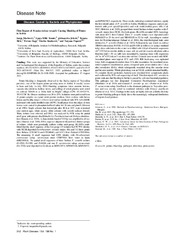Приказ основних података о документу
First report of Pectobacterium versatile causing blackleg of potato in Serbia
| dc.creator | Marković, Sanja | |
| dc.creator | Milić Komić, Sonja | |
| dc.creator | Jelušić, Aleksandra | |
| dc.creator | Iličić, Renata | |
| dc.creator | Bagi, Ferenc | |
| dc.creator | Stanković, Slaviša | |
| dc.creator | Popović Milovanović, Tatjana | |
| dc.date.accessioned | 2023-07-12T09:51:01Z | |
| dc.date.available | 2023-07-12T09:51:01Z | |
| dc.date.issued | 2022 | |
| dc.identifier.issn | 0191-2917 | |
| dc.identifier.uri | https://plantarum.izbis.bg.ac.rs/handle/123456789/653 | |
| dc.description.abstract | Potato blackleg is frequently observed in the Bačka region of Vojvodina province, one of the largest potato-growing areas in Serbia. It usually occurs in June and July. In July 2020, blackleg symptoms (stem necrotic lesions, vascular discoloration, hollow stems, and wilting of whole plants) were noted on cultivar VR808 in a 28-ha field in Maglić village (GPS: 45.349325°N, 19.542768°E). Disease incidence was 20 to 25%. Isolations were performed from 12 potato samples on crystal violet pectate medium. Stem sections with brown lesions and healthy tissue (∼10 cm) were surface sterilized with 70% (w/v) EtOH and rinsed with sterile distilled water (SDW). Small pieces from the edges of stem lesions were soaked in phosphate-buffered saline for 20 min and plated (Klement et al. 1990). Single colonies that formed pits after 48 h at 26°C were restreaked onto nutrient agar, where creamy white colonies with smooth surfaces formed. Thirty isolates were selected, and DNA was analyzed by PCR using the partial dnaX gene with primers dnaXf/dnaXr for Pectobacterium and Dickeya identification (Sławiak et al. 2009). A characteristic band of 535 bp was amplified in all isolates (Sławiak et al. 2009). DNA sequence alignment showed two distinct groups of isolates, which were genetically uniform within each group. BLASTn established that the dnaX sequence of the first group (19 isolates) had 99.79% identity with NCBI-deposited Pectobacterium versatile strains 14A and 3-2 from potato from Belarus (CP034276 and CP024842) and SCC1 from Finland (CP021894). The remaining 11 dnaX sequences had 100% identity with Pectobacterium carotovorum subsp. carotovorum strain CFBP7081 from water in Spain (MK516961). The partial dnaX sequences of three Serbian P. versatile isolates (Pv1320, Pv1520, and Pv1620) and one P. carotovorum subsp. carotovorum (Pcc2520) were deposited in GenBank as MW839571, MW805306, MW839572, and MW805307, respectively. These results, indicating combined infection, signify the first identification of P. versatile in Serbia. Multilocus sequence analysis performed with proA (proAF1/proAR1) and mdh (mdh2/mdh4) genes (Ma et al. 2007; Moleleki et al. 2013) grouped three tested Serbian isolates together with P. versatile strains from NCBI. For both genes, BLASTn revealed 100% homology with strain SCC1 from Finland. Three P. versatile isolates were deposited under MZ682623 to 25 for proA and MZ682620 to 22 for mdh. According to routine tests for Pectobacteriaceae (Schaad et al. 2001), the microbiological traits were identical to P. versatile (Portier et al. 2019). Pathogenicity was tested on cultivar VR808 with isolates Pv1320, Pv1520, and Pv1620 as follows: (i) surface-sterilized tuber slices with holes in the center were filled with 100 µl of bacterial suspension (109 CFU/ml) to test the ability to cause soft rot, and (ii) 4-week-old plants with a third true leaf (∼30 cm tall) were inoculated by injecting stems with suspension (107 to 108 CFU/ml) at 5 cm above the soil line. Controls were treated with SDW. Inoculated plants were kept at 25°C and >70% RH. Each assay was replicated twice. Soft rot appeared on tuber slices 24 h after inoculation. On inoculated stems, initial symptoms manifested as greasy elongated spots at inoculation sites 2 days after inoculation (DAI), which subsequently extended along the vascular tissue and became necrotic. Whole-plant decay was at 5 DAI; controls remained healthy. To complete Koch’s postulates, bacteria were reisolated from symptomatic plants and confirmed by PCR and sequencing of dnaX. This first report of P. versatile in potato indicates that blackleg in Serbia is caused by a diverse bacterial population. This pathogen was first designated ‘Candidatus Pectobacterium maceratum’ (Shirshikov et al. 2018) and renamed P. versatile sp. nov. (Portier et al. 2019). P. carotovorum subsp. brasiliensis is the dominant pathogen in Vojvodina province and was recently noted in combined infection with Dickeya dianthicola (Marković et al. 2021). Findings in this study are highly relevant, with the diversity in potato blackleg pathogens likely due to the increasingly widespread distribution of imported seed potatoes. | sr |
| dc.description.uri | https://enauka.gov.rs/handle/123456789/202162 | |
| dc.description.uri | http://rimsi.imsi.bg.ac.rs/handle/123456789/1542 | |
| dc.description.uri | https://biore.bio.bg.ac.rs/handle/123456789/4245 | |
| dc.description.uri | https://enauka.gov.rs/handle/123456789/202162 | |
| dc.description.uri | http://rimsi.imsi.bg.ac.rs/handle/123456789/1542 | |
| dc.description.uri | https://biore.bio.bg.ac.rs/handle/123456789/4245 | |
| dc.language.iso | en | sr |
| dc.publisher | American Phytopathological Society | sr |
| dc.relation | info:eu-repo/grantAgreement/MESTD/inst-2020/200010/RS// | sr |
| dc.relation | info:eu-repo/grantAgreement/MESTD/inst-2020/200053/RS// | sr |
| dc.relation | info:eu-repo/grantAgreement/MESTD/inst-2020/200117/RS//" | sr |
| dc.rights | openAccess | sr |
| dc.rights.uri | https://creativecommons.org/licenses/by-nc-nd/4.0/ | |
| dc.source | Plant Disease | sr |
| dc.subject | prokaryotes | sr |
| dc.subject | potato | sr |
| dc.subject | pathogen detection | sr |
| dc.subject | blackleg | sr |
| dc.title | First report of Pectobacterium versatile causing blackleg of potato in Serbia | sr |
| dc.type | Информативни прилог | sr |
| dc.rights.license | BY-NC-ND | sr |
| dc.citation.issue | 1 | |
| dc.citation.rank | M21 | |
| dc.citation.volume | 106 | |
| dc.type.version | publishedVersion | sr |
| dc.identifier.doi | 10.1094/PDIS-06-21-1128-PDN | |
| dc.identifier.fulltext | http://plantarum.izbis.bg.ac.rs/bitstream/id/2705/bitstream_2705.pdf | |
| dc.identifier.pmid | 34410856 | |
| dc.identifier.scopus | 000769542600045 | |
| dc.identifier.scopus | 2-s2.0-85124281306 | |
| dc.identifier.wos | 000769542600045 |


